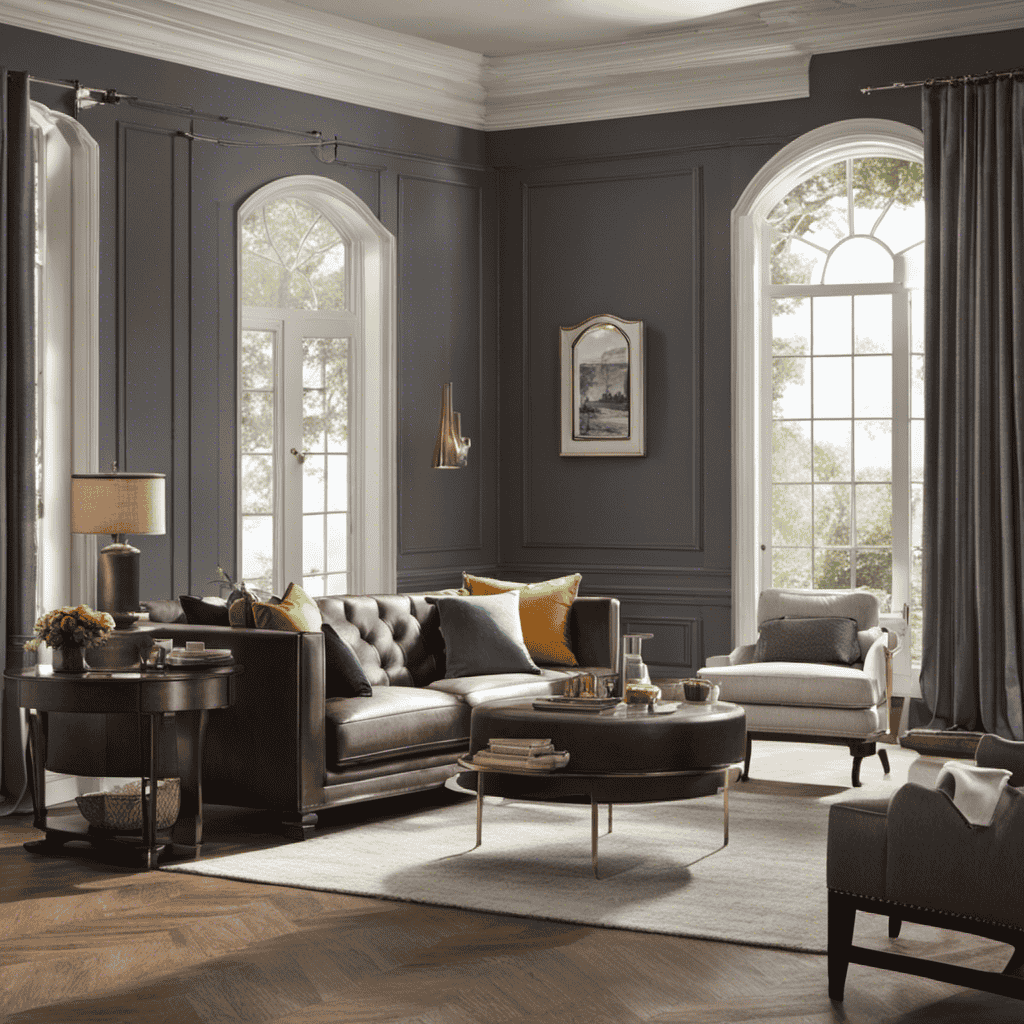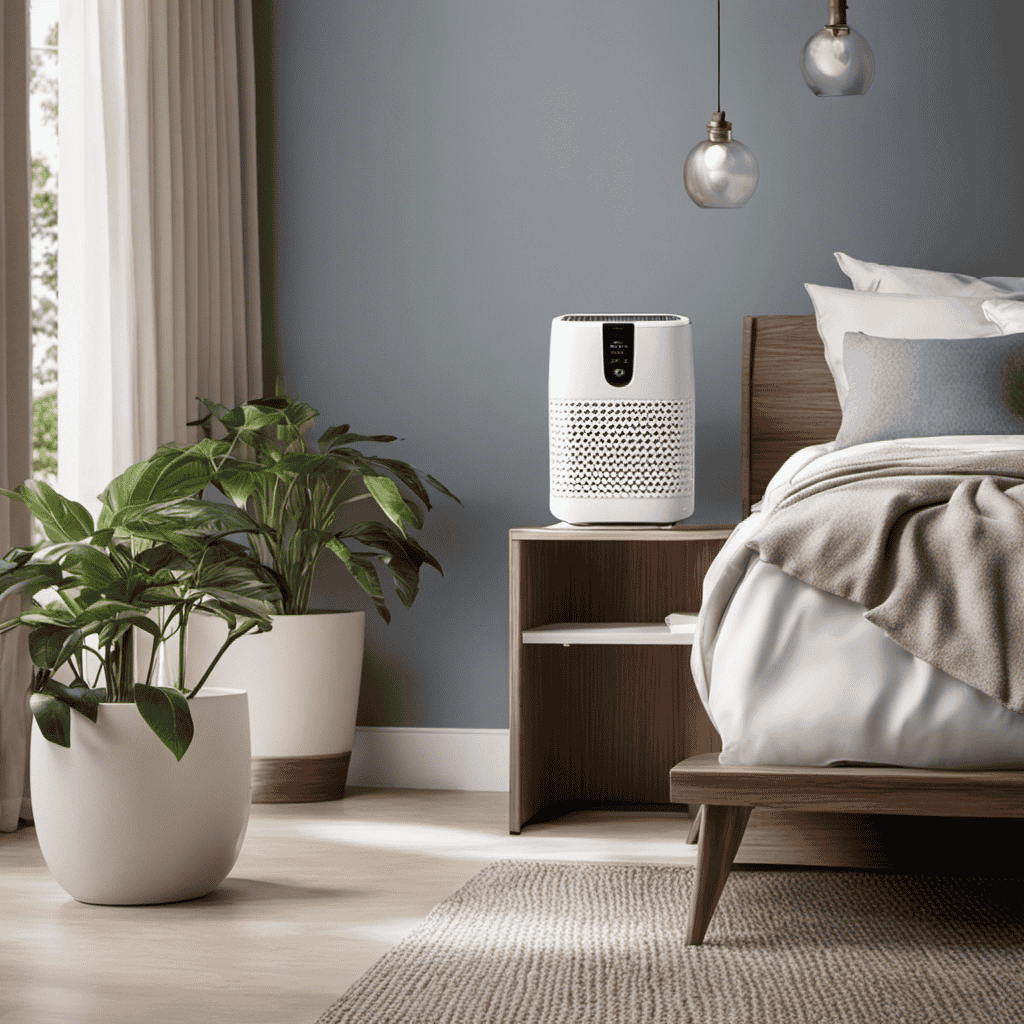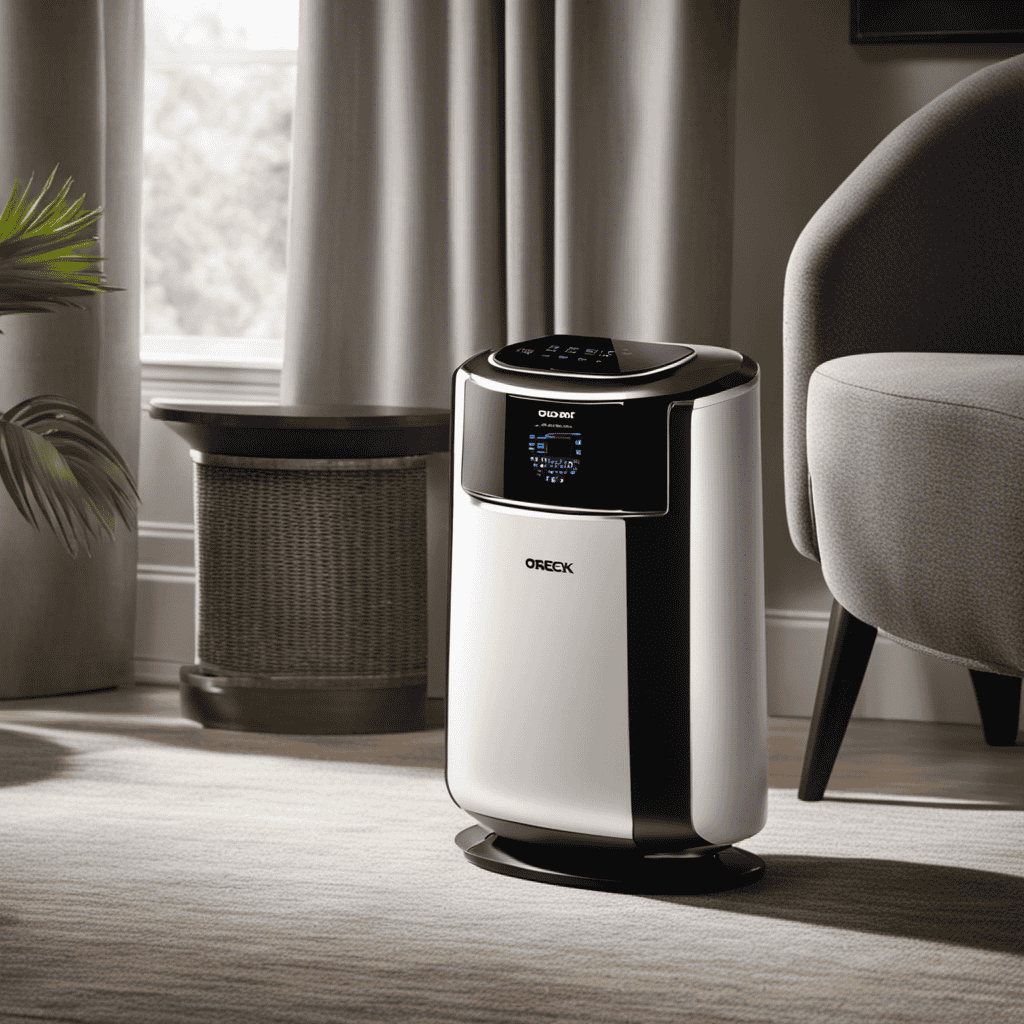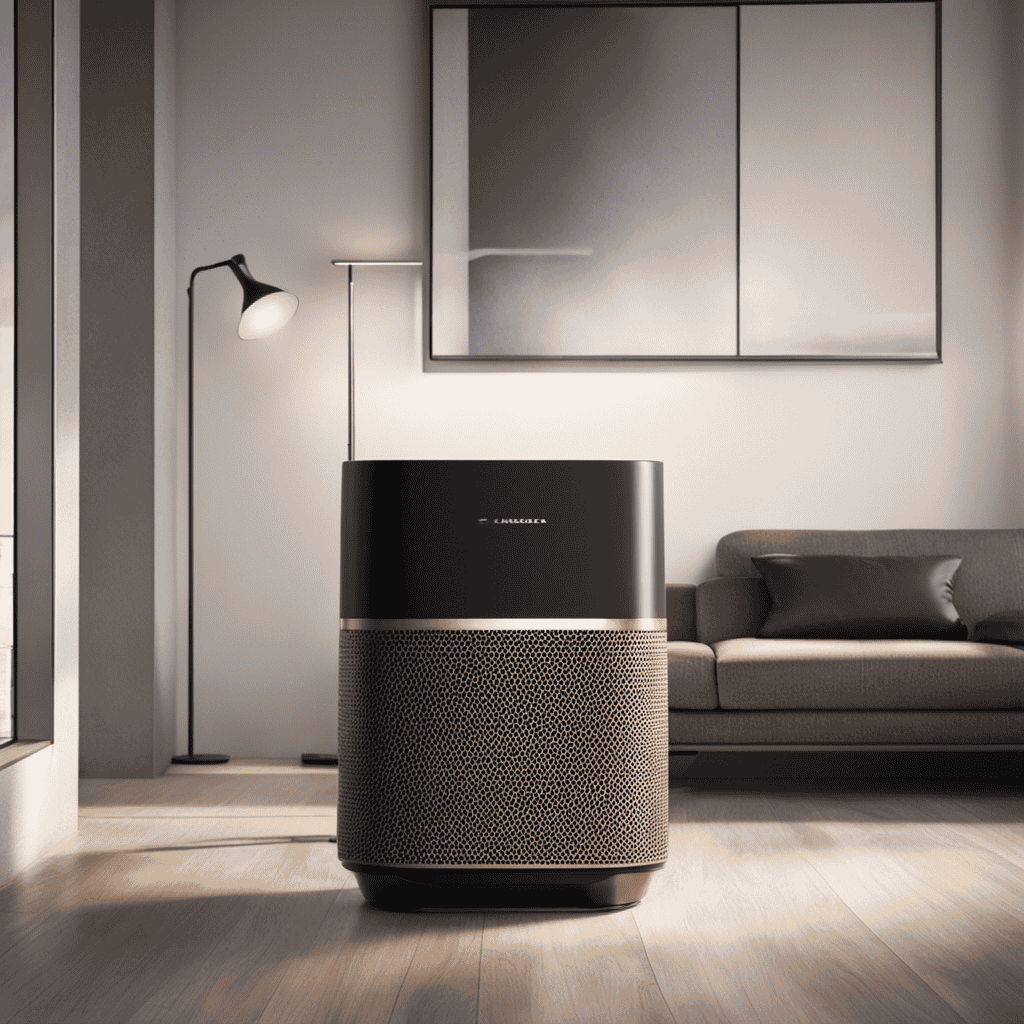I’ve always been concerned about the air quality in my home, especially with all the pollutants and allergens floating around.
Did you know that the average person spends about 90% of their time indoors? That’s why it’s crucial to have an effective air purifier that can cover the entire house.
In this article, I will guide you through the process of measuring your home to determine the perfect size air purifier you need. By following these steps, you can ensure that every corner of your house receives optimal air purification.
Key Takeaways
- The average person spends about 90% of their time indoors, making an effective air purifier crucial for whole-house coverage.
- To measure the effectiveness of an air purifier, it is important to calculate the dimensions of the living area, including length, width, and height, to determine the cubic footage.
- Factors such as room size, number of occupants, and pollutants should be considered when calculating the required Air Changes per Hour (ACH) for clean indoor air.
- Proper ventilation is essential for maintaining air quality, controlling humidity levels, and preventing stale air. Investing in ventilation solutions such as mechanical ventilation, natural ventilation, or air purifiers with ventilation features can help improve air quality.
Understanding the Air Purifier Coverage Area
To understand the air purifier coverage area, you’ll need to measure the square footage of the room you plan to use it in. This measurement is crucial because it determines the effectiveness of the air purifier in cleaning the air in your space.
When measuring the room, consider the room layout and any obstacles that may impede the airflow. It’s important to choose an air purifier that can adequately cover the entire room, taking into account the height of the ceiling as well.
Additionally, be aware of the air quality standards you want to achieve. Different air purifiers have different coverage areas, so it’s essential to select one that meets your specific needs in terms of room size and desired air quality.
Determining the Size of Your Living Space
Calculating the dimensions of your living area is essential when determining the appropriate size for an air purifier. Understanding room dimensions helps you assess the volume of air that needs to be filtered effectively.
Here are three important factors to consider when measuring your living space for an air purifier:
-
Room size: Measure the length, width, and height of your room to determine the total cubic footage. This measurement will help you choose an air purifier with the appropriate coverage area.
-
Air quality levels: Assess the air quality levels in your living space. If you have pets, allergies, or live in a highly polluted area, you may need a more powerful air purifier with higher filtration capabilities.
-
Placement: Consider the layout of your room and where you plan to place the air purifier. Ensure there is enough space around the unit for proper air circulation and efficient performance.
Calculating the Air Changes per Hour (ACH) Requirement
When it comes to ensuring clean and healthy indoor air, calculating the Air Changes per Hour (ACH) requirement is crucial.
Several factors need to be taken into account during this calculation, including the size of the room, the number of occupants, and the level of pollutants present.
Additionally, it is important to consider the significance of proper ventilation in maintaining indoor air quality and preventing the accumulation of harmful pollutants.
ACH Calculation Factors
One of the factors that affects ACH calculation is the size of the room. The airflow calculation and filtration efficiency are also important factors to consider.
When calculating the ACH, it is crucial to take into account the dimensions of the room. The larger the room, the higher the airflow required to achieve the desired ACH.
Additionally, the filtration efficiency of the air purifier plays a significant role in determining the number of air changes needed per hour. Higher filtration efficiency means that the air purifier can effectively remove more pollutants from the air, reducing the required ACH.
It is essential to consider these factors when selecting an air purifier for your home to ensure optimal air quality.
In the next section, we will discuss room size considerations in more detail.
Room Size Considerations
To ensure optimal air quality, it’s important for you to consider the dimensions of your room when selecting the right air purifier. Room size plays a crucial role in determining the effectiveness of the air purifier.
The first step is to measure the square footage of your room by multiplying the length and width. Additionally, you should also consider the shape of your room. Irregularly shaped rooms may require multiple air purifiers to ensure adequate coverage.
Another factor to consider is the placement of furniture in your room. Heavy furniture or obstructions near the air purifier can hinder airflow and reduce its effectiveness. Therefore, it is best to keep the purifier away from any obstacles.
Importance of Proper Ventilation
Proper ventilation plays a crucial role in maintaining good indoor air quality and reducing the presence of pollutants. It is essential to ensure that the air in our homes and buildings is constantly refreshed and exchanged with fresh outdoor air. Here are three important benefits of fresh air and proper ventilation:
-
Removal of Indoor Pollutants: Ventilation systems help to remove indoor pollutants such as dust, mold, pet dander, and volatile organic compounds (VOCs). These pollutants can cause allergies, respiratory issues, and other health problems if not properly removed from the indoor environment.
-
Control of Humidity Levels: Ventilation systems also help to control indoor humidity levels. Excessive moisture in the air can lead to mold growth, which can negatively impact indoor air quality and trigger asthma and allergies. Proper ventilation helps to maintain optimal humidity levels, creating a comfortable and healthy living environment.
-
Prevention of Stale Air: Without proper ventilation, indoor air can become stale and stagnant. This can result in unpleasant odors, increased concentration of pollutants, and a general feeling of discomfort. Fresh air brought in through ventilation systems helps to circulate and refresh the indoor air, promoting a healthier and more enjoyable living space.
To ensure proper ventilation and reap the benefits of fresh air, consider investing in ventilation solutions such as mechanical ventilation systems, natural ventilation methods, or air purifiers with built-in ventilation features. These solutions can help to improve indoor air quality, reduce the presence of pollutants, and create a healthier living environment for you and your family.
Assessing the Ceiling Height and Floor Plan
Assessing the ceiling height and floor plan can help determine the appropriate size of air purifier for your house. When it comes to assessing ventilation, it’s important to consider the dimensions of each room. Measure the length, width, and height of each space to calculate its volume. This information is crucial in determining the air purifier’s capacity to effectively clean the air in that particular room.
Additionally, take note of any obstacles or furniture that may obstruct the airflow. High ceilings may require a more powerful air purifier to ensure proper air circulation.
Measuring the Total Square Footage of Your Home
When it comes to selecting the right air purifier for your home, it is crucial to accurately calculate the total square footage of your living space. This measurement will help determine the appropriate purifier size needed to effectively clean the air in your home.
Additionally, understanding the efficient coverage options offered by different purifiers will ensure that you choose a unit that can adequately cover the entire area, providing optimal air purification.
Home Size Calculation
To accurately measure your house for an air purifier, you’ll need to calculate the size of your home. There are several methods you can use to estimate your home size, including:
-
Measure each room individually: Measure the length and width of each room in your home and multiply them to get the square footage. Add up the square footage of all rooms to get the total home size.
-
Use a floor plan: If you have a floor plan of your home, you can easily calculate the total square footage by measuring the length and width of each room and adding them up.
-
Use an online calculator: There are many online calculators available that can help you estimate your home size based on the number of rooms and their dimensions.
Once you have determined the size of your home, you can choose an air purifier with the appropriate capacity to effectively clean the air in your space.
Now, let’s move on to the next section about choosing the appropriate purifier.
Choosing Appropriate Purifier
After calculating the size of my house, I now need to choose an appropriate air purifier. This is crucial for ensuring clean and healthy air in my home. To make an informed decision, I will consider factors such as the type of filter and the maintenance required for the purifier.
In order to help you understand the different filter options, I have created a table below:
| Filter Type | Description |
|---|---|
| HEPA | Removes 99.97% of particles as small as 0.3 microns. Ideal for allergies and asthma. |
| Activated Carbon | Absorbs odors, gases, and chemicals. Great for eliminating pet smells and cigarette smoke. |
| Ionizer | Releases negative ions to attach to airborne particles, making them easier to capture. |
| UV-C Light | Kills bacteria, viruses, and mold spores by damaging their DNA or RNA. |
Once I choose the appropriate filter, I need to ensure proper purifier maintenance. This may include replacing filters regularly, cleaning the unit, and following the manufacturer’s instructions.
Now that I have a better understanding of choosing the right purifier and maintaining it, I can explore efficient coverage options in the next section.
Efficient Coverage Options
In order to ensure efficient coverage, it’s important to consider the size of the room and the purifier’s CADR rating. The size of the room will determine the air purifier’s capacity to effectively clean the air. The CADR rating, or Clean Air Delivery Rate, measures the speed at which the purifier can remove pollutants from the air.
When selecting an air purifier for efficient air purification, here are three important factors to consider:
-
Filter Type: Different filters target different types of pollutants, such as dust, pollen, or pet dander. Select the right filter based on your specific needs.
-
Filter Efficiency: Look for filters with a high efficiency rating. This indicates their ability to capture a higher percentage of airborne particles.
-
Filter Replacement: Regularly replacing the filters is essential for maintaining efficient air purification. Check the manufacturer’s recommendations for the filter replacement schedule.
Considering these factors will ensure that you choose an air purifier that efficiently cleans the air in your home.
Now, let’s discuss additional factors to consider for effective air purification.
Considering Additional Factors for Effective Air Purification
When measuring your house for an air purifier, don’t forget to consider additional factors that can contribute to effective air purification. In addition to the size and layout of your space, there are other features and considerations that can enhance the air quality in your home.
One important factor is the air quality measurement feature that some air purifiers offer. This feature allows you to monitor the quality of the air in your home, giving you real-time data on pollutants and allergens present in the air. By choosing an air purifier with this feature, you can track the effectiveness of the purification process and make adjustments as needed.
Additionally, some air purifiers come with additional features such as odor control, ultraviolet light sterilization, and programmable timers, which can further improve the overall air quality in your home.
Conclusion
After taking all the necessary measurements and calculations, I now have a clear understanding of how to measure my house for an air purifier.
By considering factors such as the air purifier coverage area, the size of my living space, the air changes per hour requirement, the ceiling height and floor plan, and the total square footage of my home, I can confidently choose the right air purifier for effective purification.
It’s like fitting all the puzzle pieces together to create a clean and healthy indoor environment.










